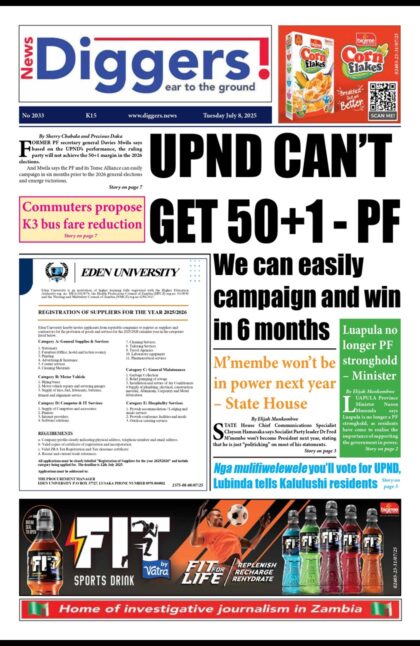Zambia’s gross international reserves have fallen below US$1.6 billion for the first time in nearly 10 years, triggered by the need to finance the country’s massive external debt servicing commitments, Bank of Zambia data reveals.
But Bank of Zambia (BoZ) governor Dr Denny Kalyalya says the central bank is not sitting idle in trying to contain the country’s dwindling reserves as various initiatives are underway to bolster the position.
Meanwhile, the BoZ has again maintained the Monetary Policy Rate (MPR) at 9.75 per cent in a bid to induce lower interest rates and continue supporting economic growth.
According to BoZ data, Zambia’s gross international reserves by the end of the fourth quarter of last year have plummeted to US $1.57 billion, the lowest in the last nine years.
International reserves are any kind of reserve funds, which central banks can pass among themselves, internationally, and they remain an acceptable form of payment among these banks.
Reserves themselves can either be gold or a specific currency, such as the dollar or euro.
BoZ data shows that Zambia’s reserves by the end of the fourth quarter of last year hit a near 10-year low of US $1.57 billion, representing just 1.8 months of import cover, compared to US $1.63 billion as at September 30, 2018, representing 1.9 months of import cover.
The last time the country’s international gross reserves were at this decade-low was in 2009 when BoZ data revealed that reserves held were at US $1.9 billion in December of that year.
According to the BoZ, the sharp decline in the country’s reserves was triggered by the need to finance Zambia’s huge external debt serving commitments.
“Gross international reserves declined to US $1.57 billion (representing 1.8 months of import cover) from US $1.63 billion (1.9 months of import cover) recorded at end-September 2018. External debt service payments were the primary drivers of the drawdown in international reserves,” BoZ data disclosed, as contained in the latest Monetary Policy Committee (MPC) statement availed, Wednesday.
The decline in reserves were, however, arrested by the central bank’s net purchases of foreign exchange, among key interventions.
“The decline was moderated by net purchases of foreign exchange by the Bank of Zambia and Mineral Royalty Tax receipts amounting to US $109.6 million in the fourth quarter of 2018. Net foreign exchange purchases from the market for 2018 amounted to US $346.0 million compared to US $402.6 million in 2017,” it stated.
But reacting to questions from journalists, Dr Kalyalya explained that the central bank was concerned with the rapid deterioration in the country’s reserves, hence some bold initiatives currently being undertaken.
“Obviously, it does concern us when it is going down. We can’t just remain at being concerned; you have to do something to try to augment the reserves. But also, we urge those who are drawing on it to look at their profile to see that…‘is it really necessary to draw reserves at this point?’ So, this is the issue of how do we rationalize the debt service that we have; does everything need to come through that window or it can be met from other sources? That’s on the demand side,” Dr Kalyalya said.
“…But on the supply side, we are also looking at how do we augment this (reserves). We started last year in September to collect Mineral Royalties directly; it’s not a whole lot. This year, we expect to do better on that particular line. We are looking at how to step up our augmentation of reserve purchases; we did buy quite a lot of resources – in excess of US $300 million. We are equally looking at how we can add to our portfolio of assets in reserves in gold so we are in conversation with those who produce gold so that we can add to our list of items. So, we are not sitting idle.”
Meanwhile, Dr Kalyalya announced that the central bank had decided to maintain the MPR at 9.75 per cent, while also keeping the Statutory Reserve Ratio (SRR) at five per cent, for the fourth successive time since last February in a bid to induce lower interest rates and continue supporting economic growth.
This means that the MPR and SRR have remained at the same level for the last one year.
The MPR is the benchmark lending rate the central bank sets on commercial banks to either increase or decrease interest rates on credit facilities, while the SRR is the proportion of deposits a commercial bank, by law, must keep in cash or place with the central bank.
Dr Kalyalya explained that the central bank decided to maintain the MPR and SRR to continue supporting the country’s economic growth, while also induce the lowering of high interest rates obtaining on the local market that increased to around 23.6 per cent in the fourth quarter last year, from 23.0 per cent by September 30.
“So, we see that interest rates have remained elevated, in fact, they edged up from 23 per cent to 23.6 per cent. So, high lending rates continue to constrain the private sector’s access to credit,” said Dr Kalyalya in front of journalists, as he explained that private sector credit growth remained slow.



















